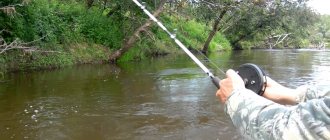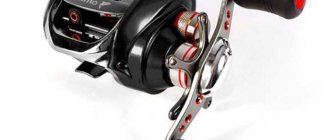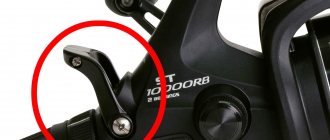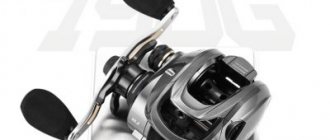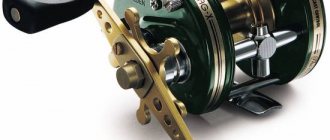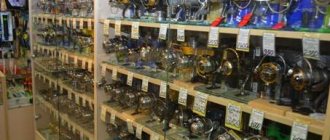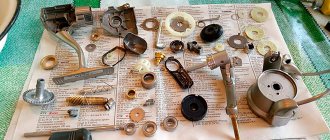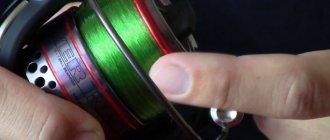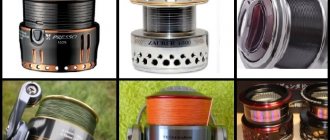What does a spinning reel consist of?
Structure (design) of a spinning reel: body (1), reel seat leg (2), drive (3), rotor (4), friction brake (5), reverse switch (6), rod for attaching the spool (7 ), line guide: bow (8) and roller (9); gear (10), cover (11).
Spinning reels for fishing (video)
We also recommend that you read reviews/feedback about the following reels:
- Daiwa Luvias review and reviews
- Daiwa Certificate
- Daiwa laguna
- Daiwa Sweepfire
- Daiwa Revros
- Daiwa Crossfire
- Daiwa Freams
- Daiwa Exist
- Daiwa Caldia
- Daiwa Crest
- Daiwa Exceler
- Shimano Biomaster FB
Daiwa Certificate
Shimano Twin Power
Daiwa Luvias 12
Daiwa Freams
Daiwa Crossfire
Daiwa Exceller
Daiwa Legalis
Daiwa Laguna
Daiwa Crest
Daiwa Revros
Daiwa Sweepfire
The principle of operation of a spinning reel
During casting, retrieving and retrieving, the spool does not rotate.
Instead, it moves back and forth, and the line guide rotates around it, ensuring an even winding of the line. Let's consider the moment of casting in more detail . The bait is cast, the line passes through the side of the spool, excluding its excessive discharge, the line guide is moved to the side so as not to interfere with the free flow of the line. When the line handle is turned, the line ends up on a roller that winds it onto the spool.
Basic rules for using a spinning reel
Of course, every self-respecting angler should know how to use a spinning reel installed on his fishing rod, what loads it is designed for, what can be expected from it in a given situation and how it needs to be configured for effective operation.
Due to their versatility, they are in high demand among different categories of fishermen, so manufacturers produce different models that can more fully satisfy their needs. Let's consider the most important nuances that need to be taken into account when operating inertia-free motors.
Mechanism and speed of rotation of the rotor in the BC
The rotary mechanism includes a main pair and a spool feeding device. The rotor has a wheel that drives a gear on the main shaft. It starts to rotate due to the rotation of the handle. It is mounted in a hole with 4 edges located on the shaft. The main pair is the gearbox, it has a specific gear ratio.
The speed at which the rotor rotates depends on the gear ratio of the drive and how fast the handle rotates. According to the gear ratio, BCs for spinning rods are classified as follows:
- Power (the coil makes one revolution, and the rotor makes from 3.2 to 4.3 revolutions during this time) for trolling, suitable for slow retrieving.
- Universal (from 4.5 to 6.1 turns). Any wiring pace.
- High-speed ones (from 6.2 to 7.2) for twitching and jigging.
Inertialess reel: its structure and characteristics
Spinning reels are parts of fishing gear that are designed to store a large supply of fishing line. They participate not only in the process of casting gear, but also in the moment of retrieving hooked fish. In fishermen's slang it is called a “meat grinder.”
The design of the coil is quite simple; it has 4 main parts:
- Housing with a drive mechanism and a claw for attaching to the fishing rod.
- Rotor with folding line handle.
- Fixed spool.
- Handle for rotating the mechanism.
All other elements found in some models are classified as utilities that facilitate the performance characteristics and increase the efficiency of the reel.
All coils can be characterized by the following characteristics:
- by gear ratio;
- by the number of bearings;
- by spool type;
- by spool capacity;
- by product dimensions;
- by weight.
In addition to this, there are other indicators that fishing enthusiasts focus on. This is the load on the clutch and the length of the fishing line wound per revolution of the handle.
Gear ratio and winding speed
The gear ratio tells you how many revolutions the rotor makes during a single revolution of the coil. A 5:1 gear ratio means that when the spool is turned once, 5 rotor revolutions occur.
The rewind speed shows how much line is wound onto the spool with one turn of the handle. This indicator depends on the diameter of the spool and the gear ratio. For example, the gear ratio is 5:1, the spool diameter is 0.4 cm. Rewind speed: 3.14 multiplied by 5 and 40, we get 628. For a single revolution of the reel handle, 628 millimeters of fishing line is wound onto the spool.
This calculation is approximate due to the approximate diameter: the amount of fishing line in 1 turn depends on the degree of filling of the spool.
How to lubricate spinning reels
Common tips for lubricating spinning reels:
- Optimal lubricant from the same company that manufactured the reel.
- Before applying the lubricant, you need to carefully remove the waste residues of the previous one. Typically, two lubricants cannot be mixed with mineral and synthetic components in the composition.
- In extreme cases, Tsiatim 203 is suitable as a lubricant for a spinning reel, and oil used for household sewing machines is suitable as a liquid composition.
- There is no need to lubricate the coils with WD-40 liquid or motor oils. In particular, you should not do this for a reel containing a large number of plastic parts. It is important! Additives and WD-40 liquid used in motor oils can destroy the coil mechanism.
Lubricant for spinning reels EFELE is suitable for all components:
Lubricant for spinning reels EFELE
How and with what to lubricate a spinning reel - video instructions from disassembly to assembly:
How to lubricate
Disassembled parts should not be lubricated separately, as during assembly the parts will slide, making it difficult to install in their place. Because of this, there is a possibility of the elements slipping out of your hands and falling onto a dirty surface, and this may lead to the need for repeated cleaning.
It is better to lubricate the entire mechanism assembly, and do a complete disassembly to remove sand, water and remnants of old lubricant.
Fishing is a fun pastime, but to be successful, you need to take preparation and maintenance cycles seriously on important parts in your fishing equipment.
Gears and Parasitic Gear
The smaller the gears in the main pair, the weaker the coil. Spinning requires larger gears.
FluiDrive Gearling - the main pair gears are a gear mechanism with smooth movement.
Digital Gear Design - marking of a reel in the production of which computer technology was involved.
Haper Gear is a reel whose gear teeth are subjected to additional machining to improve grip and reduce backlash.
The parasitic gear can be shaped like a square or a circle. The square-shaped gear helps to wind the line onto the spool more evenly, including at the sides. The parasitic gear is also ellipsoidal in shape, and the carriage is connected to it by means of hinges.
Device
In most Western countries, inertial reels are called centrepins due to the location of the entire structure on a single central axis around which the spool rotates. The design of classic gear is extremely simple and consists of a minimum number of parts:
- The main drum on which the fishing line is wound. It can be of different sizes depending on the amount of cord and the type of fishing - small models are better suited for dynamic casting and retrieving, and, on the contrary, those with a larger diameter are better suited for bottom fishing.
- The central axis on which the moving part of the coil is located. In modern versions of gear, it can be equipped with a bearing or a special cone for better rotation.
- A handle located directly on the drum. The angler rotates by applying direct force to it, since there are no transmission gears in the design.
- To keep the reel from involuntary rotation, it is also equipped with a reverse stopper, which is popularly called a ratchet.
- Some inertial reels are additionally equipped with a mechanical brake.
Most often, such gear is made of metal, which, coupled with a proven mechanism and simple operating principle, makes them practically insensitive to shocks, jerks and dirt - even the ingress of leaves or small twigs cannot particularly affect their functioning.
Spinning reel spool feeder
The movements of the bobbin feeder are reciprocating . There are 2 types of such a mechanism:
- with screw drive;
- with a rocker gear.
The rocker device includes a small gear, a parasitic gear, a carriage and guides for it, a rod for feeding the spool and its fastening. The handle rotates, the small gear also begins to rotate and transmits force to the parasitic gear, which, in turn, sets the carriage in motion.
The spool on the rod moves similarly to the carriage. This way the line is laid evenly on the spool.
For spinning, it is better to use a spinning rod with a screw spool feeder.
Screw feeder
Rotation from the main pair is transmitted to the carriage through the cam shaft of the drive gear. Most BC models are equipped with endless screws. These screws have cross threading and the groove spacing is different.
Due to the different pitch, the spool moves forward at one speed and backward at another.
This ensures high-quality laying of even very thin fishing line: its upper layer does not sink into the lower one, and the fishing line does not get tangled.
Profile types
3 geometric shapes of spool profiles are possible:
- Cylinder.
- Cone.
- Inverted (reverse) cone.
Casting techniques with a spinning reel
The main condition for good fishing is the correct throwing technique. If the amplitude of the cast and its sharpness are calculated correctly, then a good result is guaranteed. We will now look at how to properly throw a spinning rod with a spinning reel, what techniques are available and in what cases it is more appropriate to use them.
Casting a spinning rod with a spinning reel can be done in several ways:
- vertically (over the head);
- horizontally;
- according to the principle of a pendulum;
- according to the principle of a catapult.
Vertical method
To cast a spinning rod vertically, you must perform the following steps:
- Fold out the line handle;
- Release the bait 1/3 or 2/3 of the length of the rod;
- Using your index finger, secure the line;
- Place the rod behind your back;
- At the same time, send the bait with a sharp movement of your hand forward and release the line.
While the bait is flying, the rod should be positioned so that its tip points in the direction the bait is expected to splash down. In this case, the spinning rod does not need to be raised too high; the fishing line and the blank should form one line.
Lateral or horizontal method
If you are wondering how to cast a spinning rod with a reel sideways, then you should know that this technique is suitable for places with dense vegetation, when it is impossible to do this vertically due to branches hanging from above.
The technique is almost no different from the previous method, with the exception of the position of the rod, which is also retracted behind the back, but in a horizontal position.
Pendulum method
To cast a fishing rod using the pendulum method, you must perform the following steps:
- Fold out the line handle;
- Release the line 2/3 of the rod length;
- Using a blank, swing the bait like a pendulum and send it forward.
In this case, the bait will fly from bottom to top.
Ejection method
To ensure a perfect ejection cast, you need to perform the following steps:
- Fold back the line handle while holding the rod in your right hand;
- Take the bait in your left hand by the last tee, pull it back, you should get a bend in the rod;
- Release the bait, having previously determined the place where it will splash down.
As soon as the upper part of the spinning rod straightens up, the bait will quickly fly to the right place.
Which type of casting should you choose and why?
We have figured out how to cast a spinning rod with a spinning reel, all that remains is to decide in which cases this or that technique is suitable.
the side method if a place with dense vegetation, tall bushes or trees has been chosen for fishing. In case of strong gusts of wind, it is also recommended to use this technique.
the vertical method, over the head, if you need to perform the most accurate cast. The accuracy of this method for an experienced fisherman always guarantees 100% results.
Casting from under the hand will be convenient when two fishermen are on the same boat. In order not to interfere with each other, this method of casting is the most suitable.
Casting over the shoulder is suitable when a fairly narrow place has been chosen for fishing. The most powerful results can be achieved by throwing a spinning rod with both hands.
How to cast a spinning rod correctly?
Knowing casting techniques is not enough; you need to know how to throw a spinning rod with a spinning reel correctly. To get the most accurate and effective throw, you need to follow some rules:
- Before throwing, look around to see if there are people nearby whom you might accidentally hit. But most importantly, look up to see if there are any power lines above you; the danger of such a neighborhood is not worth explaining. Branches hanging over your head will also interfere with casting;
- if you are interested in casting as far as possible, then release the line at an angle of 45 degrees;
- Casting accuracy comes with experience, so you shouldn’t expect it on your first fishing trip.
Rotor backstop
Another name for this device is anti-reverse .
When it is turned on, the rotor and handle cannot rotate in the reverse direction. Previously, it was believed that anti-reverse was needed only for transporting a spinning rod: the nozzle hooks onto the ring and the reel stops. It was not considered necessary to turn on the stopper while fishing. A coil like the Orion even emitted special signals, notifying that the anti-reverse was working. Only after a while did they appreciate the convenience of fishing with the stopper turned on. When cutting sharply, the left hand may miss the handle, but despite this, the cutting will be completed: the friction brake will work.
First, a reverse stopper was developed using a step principle of operation: the lever rested against the teeth of the ratchet, moving in the opposite direction. But such anti-reverse did not have an instant effect. In addition, a strong jerk led to a powerful blow to the stopper ratchet, which quickly disabled it.
The instantaneous stopper was made on the basis of a needle bearing. The load on the reel has decreased, the handle and rotor have stopped “dangling” when braking.
Both types of anti-reverse are now used. Stepped - when fishing with a thin monofilament line, instant - when fishing with a line.
What to look for when choosing a reel
Choice is always a difficult matter. Each manufacturer has many lines with different sizes. Not only a beginner, but also an experienced spinning player will not be able to immediately understand the wide range of reels and their characteristics in order to make the right decision about purchasing the right model.
Number of bearings
One of the main characteristics of the reel that people pay attention to. The quantity can reach up to 13 pieces. They serve for smooth and soft operation of all components and mechanisms of the reel. Some little-known manufacturers mislead buyers by indicating a large number of bearings, which in reality may be half as many.
It is recommended to choose a reel that has a metal bearing in the line roller. This element is subject to constant loads and contamination. If the roller does not function, the line or braided cord will be subject to high friction, and the cord will soon easily cut a groove in the roller.
The relationship between the diameter of the fishing line and its quantity
Each spool has a capacity indicated, that is, how many meters of fishing line of a certain diameter the spool can hold. It is necessary to select a reel for the diameter of the fishing line used so that it can accommodate at least 100 - 150 meters. There is no general classification of coils by size. But most anglers are accustomed to relying on the system from Shimano, where reels are classified by size 1000, 2000, 2500, 3000, 4000, 5000, 6000.
Having similar sizes of reels from other manufacturers, the capacity of their spools may not coincide with the capacity of Shimanov's. The designation 0.3/150 indicates that 150 meters of monofilament line with a diameter of 0.3 mm can be wound onto the spool.
Brake clutch
Spinning reels can have two types of friction brake: front and rear. It is necessary to prevent rotation of the spool when winding under load, as well as to release the line during strong jerks of the fish. This prevents the line from breaking if its breaking load is significantly less than the effort during fishing.
Reels with rear drag are used for feeder or carp fishing, when it is impossible to immediately and precisely adjust the drag to the expected size of the fish. In this type of fishing, the fisherman does not hold the rod directly in his hands until he bites. When fishing for large carp, reels with a rear drag and a baitrunner are used, which resets all clutch settings at the first sharp jerk of the fish in order to avoid breakage of the equipment.
Long casting system
Casting range is an important component for a spinning player. The farther you can throw the bait, the larger the area you can fish. There are several methods to increase the casting distance of a reel. Some manufacturers use a special spool shape, tapered, when the spool increases towards the base of the reel. The farther turns of the line have a larger winding diameter than those at the edge of the spool. This allows them to come off without additional friction on the spool collar. Such spools are usually used when fishing for carp.
Casting distance can be increased by using reels with larger spools and shallower spool depths. This allows the line to flow more freely without additional friction on the spool collar with the lower turns.
Spare spool
A nice bonus that not every manufacturer provides for a specific model. A spare spool is necessary when fishing you need to change equipment to a more sensitive one or, conversely, with a higher breaking load. This is much cheaper than buying a completely new additional set of spinning rod and reel.
Traction force
An important component that few people pay attention to. Indicated in kilograms. This is the maximum force that the reel can handle when landing fish without the help of a rod, that is, working like a winch. For fishing with heavy, stubborn baits or large fish, it is recommended to use reels with a pulling force of at least 5 kg. Otherwise, the reel can simply be “killed” by frequent idle casts in just a few seasons.
Gear ratio
For spinning fishing it is not of great importance, since it is not the speed of winding the line onto the reel that is important, but the correct action of the bait. This indicator is important when fishing with a match, feeder, or carp rod, where the speed of reeling and new casting is very important for saving time.
Spool material
They can be made from light alloys, plastic, graphite. Plastic spools are used only if monofilament fishing line is used. The braided cord will cut through it. Light alloy spools are preferred for spinning fishing. To protect the spool from wear, its collar must be coated with titanium nitrite.
Reel weight
As a rule, experienced spinningists pay attention to this parameter, or if a reel for ultralight tackle is needed. Less weight will reduce stress on your arms. It is more pleasant to fish with light tackle; you don’t feel tired after a hard day of fishing. Less weight gives the spinning tackle greater balance.
Types of line laying on the spool
- Direct laying. This type of laying is the most popular, but it does not guarantee that the line will not come off spontaneously.
- Conical. For long casts. High probability of fishing line tangling.
- Reverse cone. For short casting distances. The likelihood of the line getting tangled is minimal.
There are 2 ways to attach the spool: hard or with a button on the lock. The second method allows you to replace the bobbin.
The spool is usually made of a metal-polymer alloy.
Spool: filling, capacity
Before securing the fishing line, the spool is removed : unscrew the screw located in front of the spool and press the button located on it (if the clutch is rear).
Next, you need to open the line guide. Place the spool on the axle and tighten the screw. There is no need to use force during installation . The latch clicks to indicate that the spool is installed.
Having closed the line layer, we proceed to winding the fishing line. For a more even winding, it is recommended to tighten the fishing line. To avoid problems during operation of the reel, at least 2 millimeters should remain from the edge of the spool to the fishing line.
The spool capacity is specified by the reel manufacturer in the user manual.
Why is it necessary to do regular service for coils?
Each piece of equipment, like fishing reels, requires systematic inspection in situations of frequent use, violations of operating rules, as well as to ensure proper storage during the off-season. In particularly difficult cases, coil repair may be necessary.
It would seem that a not so often used element from the kit of an avid fisherman needs to be inspected in a timely manner in order to identify atypical crunching noises, noises and other malfunctions. If the equipment is not stored correctly, the internal parts of the mechanism may rust and also oxidize. Thus, the service life of such a coil will be significantly reduced.
If you take into account the gear you regularly use during fishing, you will notice that the reel most often comes into contact with water and coastal sand. This is aggravated by the fact that the reel, especially the inertia-free one, consists of many small parts (gears, bearings, etc.) that will not work adequately without timely lubrication of all parts.
And the inertialess coil device disassembled
If debris gets into the moving parts of the reel, you must immediately clean the equipment on site.
It is necessary to partially wipe with a napkin, because the sand will remain in inaccessible places, and subsequently cause damage to the bushings, bearings, and gears. Due to this, the life of the coils will be significantly reduced, and this may cause a malfunction.
The device of the inertia-free coil outside
How to understand that a coil service is required
Typically, the need for regular maintenance of a reel operating on the inertia-free principle can be understood by the following distinctive points:
- the period of the first fishing after winter downtime begins;
- mid-season;
- diagnosing atypical sounds and current viewing of all moving elements to make sure there are no unusual noises or difficult movement of internal elements;
- systematic inspection throughout the fishing season in order to determine the integrity of the condition of bearings, gears, bushings, as well as the color of the oil, contamination, leakage;
- extraordinary diagnostics if incorrect operation of the mechanism is detected: uncharacteristic noises arise, there is creaking, moving structures are difficult to move, backlash has formed, there is sand contamination.
Lubrication and repair of spinning reels should be carried out several times a season and after falling into water or sand.
In reality, it is optimal to do diagnostics quite often - every 2 months during the season. This frequency must be observed if there are no tangible indications for immediate diagnosis.
Thus, diagnostics and periodic inspection will help avoid more serious breakdowns.
Handle
The handle sets the rotational movement of the mechanism. Many BCs have a handle folding system that is activated after pressing a button, as well as a screw device for changing the position of the handle.
There are models without a push-button system. You can fold and rearrange the handle using a screw mechanism.
To do this, the screw is loosened, the handle is set in the desired position, and the screw is tightened again, fixing this position.
To rearrange the handle in this case, the screw is unscrewed, removed, the handle is moved to the opposite side of the reel body, the screw is screwed into the hole until it stops.
High-speed reels are equipped with a double handle. They may have one handle, but supplemented with a compensator that prevents vibrations due to unbalanced handles.
How to disassemble a spinning reel
First you need to remove the reel handle, spool and spool holder. These parts are easy to remove, as the manufacturer has provided mounting structures.
Then the shaft sleeve is disassembled, where the adjusting washers and bearing are located. Here you need to use tweezers and simple toothpicks.
The overrunning clutch cover is secured with bolts. They must be unscrewed using a suitable screwdriver. Often the bolts are designed with asterisks or hexagons. This fact must be taken into account in the process of preparing the required tool.
Remove the coupling from the bearing and wipe the contaminated areas dry with a rag, as well as remove dirt and debris. To most effectively remove all deposits, VD-40 is used.
Then you need to unscrew the anthers. After this you will be able to remove the cover.
Here you will have access to the gears. You will need to make special marks on the teeth so that the marks match exactly during the assembly process. Then the coil will work exactly as before.
Next, the main gear and stop box are dismantled.
Now you can disassemble the carriage, which is fixed with a stopper. Once it is removed, the first part is simply dismantled.
After this, the coil is completely disassembled. It is advisable to film the entire disassembly process, this will allow you to easily reassemble the coil after completing maintenance.
Important information! As a result of correct actions, the device is disassembled into all components. The correct step would be to lay out all the resulting parts on a dry, wiped surface in the sequence of dismantling work that was done.
It is optimal to record a specific stage of all actions in a photo for clear perception. Thus, there should be no problems during reassembly.
Adjusting the brake mechanism
When the load on the line is maximum (at the moment of pulling the prey, a strong jerk), a brake is used .
Its adjustment can be either front or rear. The brake is a wing located on the spool, or a handle. You can operate the braking system using flag or slide switches.
To adjust the friction, the fishing line is threaded into the rings of the spinning rod, passing through the line guide. We secure its end and turn on the reverse stop.
The angle of installation of the rod is 45 degrees . The brake activation threshold is set with an adjusting screw. When the limit is reached, the regulator is turned 1/4th of a turn in the opposite direction.
Be careful: if you apply too much force when adjusting the clutch, the reel or spinning rod can be broken.
How to Use a Spinning Reel Video
A multiplier is one of 3 types of fishing reels. It is correct to call such reels multipliers. They work on the principle of an inertial reel, but have a gear ratio and an effective braking system to prevent tangling of the fishing line and the release of beards.
Multipliers are divided into two groups:
Trolling reels are more expensive than traditional baitcasting reels , but if you need a counter, you have a regular baitcasting reel - you just need to mark your fluorescent line with a waterproof black marker. This way, every time you can easily send the bait to the required distance from the boat and, accordingly, to the depth you are interested in.
What is needed, we will analyze it one by one, what remains for our client to do, the nuances of choosing multiplier reels.
Choose reels with an iron body and friction , this will increase the service life and reliability of your purchase. In most cases, duralumin alloys act as metal. But plastic reels are a more economical option and you need to prepare for the fact that the service life of such a multiplier will be less than that of the same one, but made of aluminum.
These two types of brakes allow you to slow down the rotation of the drum starting from the moment of rapid spin-up at the moment of casting. If it were not for the brakes, the drum of the baitcasting reel would spin faster than the fishing line coming off it - we would get a beard, tangling the fishing line.
Spinning for beginners, assemble a spinning rod and tie a leash
Magnetic braking is based on the braking of a very rapidly rotating spool since childhood using small magnets. And this type of braking and centrifugal must be adjusted manually depending on the duration of the project, what weight of the bait you use.
centrifugal braking - small weights protrude from the center, which of course move from the center of the reel to the edges. At the time of very fast rotation of the reel by centrifugal force - they come out and begin to rub a special partition, due to the set of such a factor, braking occurs at excess speed at the initial casting step.
A mechanical brake is a manual type of brake (all reels have it), which should be used already at the end of the bait, when it touches the water. Due to the use of a mechanical brake, the multiplier reel reacts to a weak descent of the fishing line from the reel and brakes the reel in a more effective manner for long casting.
Care and precautions
- The line should not come into contact with the rotating parts of the reel.
- When leaving the coil to be stored until next use, you need to make sure that it is dry.
- Every year it is recommended to open the reel body and lubricate its mechanism with a special lubricant.
- The reel should be used according to the instructions, otherwise if it breaks down you will have to rely on your own efforts: the warranty does not cover damage caused by incorrect use of the reel.
- After use, the reel should be wiped with alcohol (open areas) and the line roller should be lubricated with lubricant.
There are a lot of parts in a spinning reel. “Inertialess”, because there is no inertia on the drum when casting, the position of the spool in the reel is fixed. This is a complex device. If you take care of it and take precautions, the BC will last for many years. If it is working properly, it is not recommended to disassemble the coil more than once a year. With knowledge of how a spinning reel works, no breakdown will take you by surprise!
For information on the prevention of spinning reels, watch the video. Enjoy watching!
Pros and cons of spinning reels
As mentioned above, reels of this type are preferred by most fishermen. What are their advantages and disadvantages?
Advantages of spinning reels:
- One of the advantages of such reels is the ability to fish with both light and heavy bait.
- If we talk about wiring, then such a coil allows you to perform both slow and fast wiring.
- The presence of a rear or front friction brake completely eliminates line snatching.
This part is also not without its disadvantages:
- Rapid wear of the fishing line due to its frequent twisting.
- High price.
